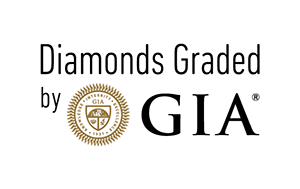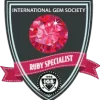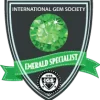

The jewelry industry uses special terms for manufactured and look-alike gemstones: synthetic and simulant. The differences between them are subtle, but very important. Synthetic refers to a man made material with essentially the same chemical composition, crystal structure, and optical and physical properties as the natural gem material. There are also materials that simply look like natural gems. These products are called simulants or imitations, and can be either natural or man made. Substitute is an older term for the same thing.
Common imitant gem materials
Strontium titanate – this colorless manmade material became a popular diamond simulant in the 1950s. However, its dispersion (the optical property that creates fire in a faceted gemstone) is over four times greater than diamond. Strontium titanate is most often produced by the flame-fusion method and can be made in colors, such as dark red and brown, by adding certain chemicals during the growth process. Prevalence: rare.
YAG and GGG – several manmade materials have been used as diamond simulants over the years. In the 1960s, yttrium aluminum garnet (YAG) and its “cousin” gadolinium gallium garnet (GGG) joined classic simulants like glass, natural zircon, and colorless synthetic spinel. YAG and GGG are also available in a variety of colors. Prevalence: rare.
Synthetic cubic zirconia (CZ) – early diamond simulants have been almost entirely replaced in the past three decades by colorless CZ. It is made by a process called skull melting. As the material melts, the outer portion is kept cool to form a solid crust which then contains the melt. CZ can be produced in almost any color, and in darker hues, it is a convincing alternative for gems in purples, greens and other dark tones including black. Prevalence: common.
Glass – manufactured glass is an age-old gem imitation that is still used today. Since glass can be manufactured in virtually any color, this makes it a popular substitute for many gems. Although it is less brilliant, glass is used to imitate stones like amethyst, aquamarine, and peridot. It can also be made to look like natural phenomenal gems, like tiger’s eye and opal, and fused layers of glass can imitate the look of agate, malachite, or tortoise shell. Prevalence: common.
Quench crackled quartz – Natural colorless quartz can sometimes be subjected to thermal shock, known as “quench crackling.” The colorless material is first heated, and then subjected to quenching in a cold, liquid solution—such as water. The sudden contraction causes the material to develop a series of cracks that radiate throughout. Because these are surface-reaching fractures, the quartz can then be subjected to additional immersion in a dye solution, allowing the fractures to be filled with colored liquid. This makes a convincing simulant to such natural gems as emerald, ruby and sapphire, although the fractured and dyed appearance can quickly be seen under the microscope. Prevalence: occasional.
Doublet – a doublet consists of two joined segments. Prevalence: common.
Triplet – a triplet has three segments, or two segments separated by a layer of colored cement. Prevalence: common.





